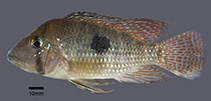| Family: |
Cichlidae (Cichlids), subfamily: Geophaginae |
| Max. size: |
10.29 cm SL (male/unsexed) |
| Environment: |
benthopelagic; freshwater |
| Distribution: |
South America: Brazil. |
| Diagnosis: |
This species is distinguished from all other species of G. brasiliensis group by having small pale blue spots with minute bright blue dots on its centre, usually vertically coalesced to form short bars on the caudal fin (vs. never a similar pattern); further distinguished from G. rufomarginatus, G. obscurus, G. santosi, by the absence of an oblique iridescent blue zone between humeral region and anterior portion of dorsal-fin base (vs. present); differs from G. rufomarginatus by having dorsal-fin lappets with grey or dark brown edges (vs. red), with denticles on gill-rakers of the first branchial arch (vs. absent) and without longitudinal series of small light blue spots between anal-fin spines and rays (vs. present); differs from G. santosi by having blue bands crossing anal-fin rays (vs. blue bands parallel to fin rays); differs from G. itapicuruensis with D XIV (vs. XIII), lateral spot rounded (vs. elliptical), no horizontal dark brown band on snout (vs. presencet); differs from G. brasiliensis by having longitudinal blue bands crossing the anal-fin rays (vs. transversal blue bands crossing the anal-fin rays) and mouth subterminal (vs. subdorsal) (Ref. 119412). |
| Biology: |
|
| IUCN Red List Status: |
Not Evaluated (N.E.) Ref. (130435)
|
| Threat to humans: |
harmless |
| Country info: |
|
Source and more info: www.fishbase.org. For personal, classroom, and other internal use only. Not for publication.

